
56. The mass of a particle is m. In order for its total energy to be twice its rest energy, its
momentum must be:
A. mc/2
B. mc/√2
C. mc
D. √3mc
E. 2mc
ans: D
57. If the kinetic energy of a particle is equal to its rest energy then its speed must be:
A. 0.25c
B. 0.50c
C. 0.87c
D. c
E. unknown unless its mass is given
ans: C
58. If the mass of a particle is zero its speed must be:
A. c
B. infinite
C. 0
D. any speed less than c
E. any speed greater than c
ans: A
59. A particle with zero mass and energy Ecarries momentum:
A. Ec
B. Ec2
C. √Ec
D. E/c
E. E/c2
ans: D
60. According to relativity theory a particle of mass mwith a momentum of 2mc has a speed of:
A. 2c
B. 4c
C. c
D. c/2
E. 0.89c
ans: E
Chapter 37: SPECIAL THEORY OF RELATIVITY 571
Simpo PDF Merge and Split Unregistered Version - http://www.simpopdf.com

61. If the kinetic energy of a free particle is much greater than its rest energy then its kinetic
energy is proportional to:
A. the magnitude of its momentum
B. the square of the magnitude of its momentum
C. the square root of the magnitude of its momentum
D. the reciprocal of the magnitude of its momentum
E. none of the above
ans: A
62. If the kinetic energy of a free particle is much less than its rest energy then its kinetic energy
is proportional to:
A. the magnitude of its momentum
B. the square of the magnitude of its momentum
C. the square root of the magnitude of its momentum
D. the reciprocal of the magnitude of its momentum
E. none of the above
ans: B
63. The magnitude of the momentum of a particle can never exceed:
A. mc, where mis its mass
B. E/c, where Eis its total energy
C. K/c, where Kis its kinetic energy
D. none of the above, but there is an upper limit
E. none of the above; there is no upper limit
ans: B
64. An electron (m=9.11 ×10−31 kg) has a momentum of 4.0×10−22 kg ·m/s. Its kinetic energy
is:
A. 6.3×10−14 J
B. 8.2×10−14 J
C. 1.2×10−13 J
D. 1.5×10−13 J
E. 2.7×10−13 J
ans: A
65. A certain particle has a kinetic energy of 3.2×10−10 J and a momentum of 1.7×10−18 kg ·m/s.
Its mass is:
A. 9.11 ×10−31 kg
B. 2.7×10−27 kg
C. 4.5×10−27 kg
D. 6.3×10−27 kg
E. 8.6×10−27 kg
ans: B
572 Chapter 37: SPECIAL THEORY OF RELATIVITY
Simpo PDF Merge and Split Unregistered Version - http://www.simpopdf.com

66. An electron (m=9.11 ×10−31 kg, q=1.60 ×10−19 C) travels at 0.95caround a circular orbit
perpendicular to a uniform 1.8-T magnetic field. The radius of its orbit is:
A. 0.28 mm
B. 0.90 mm
C. 1.1mm
D. 2.9mm
E. 4.7mm
ans: D
67. An electron (m=9.11 ×10−31 kg, q=1.60 ×10−19 C) travels around a 1.7-mm radius circular
orbit perpendicular to a 2.8-T magnetic field. Its speed is:
A. 0.16c
B. 0.36c
C. 0.94c
D. c
E. 2.8c
ans: C
Chapter 37: SPECIAL THEORY OF RELATIVITY 573
Simpo PDF Merge and Split Unregistered Version - http://www.simpopdf.com

Chapter 38: PHOTONS AND MATTER WAVES
1. The units of the Planck constant hare those of:
A. energy
B. power
C. momentum
D. angular momentum
E. frequency
ans: D
2. If his the Planck constant, then ¯his:
A. 2πh
B. 2h
C. h/2
D. h/2π
E. 2h/π
ans: D
3. The quantization of energy, E=nhf , is not important for an ordinary pendulum because:
A. the formula applies only to mass-spring oscillators
B. the allowed energy levels are too closely spaced
C. the allowed energy levels are too widely spaced
D. the formula applies only to atoms
E. the value of hfor a pendulum is too large
ans: B
4. The frequency of light beam A is twice that of light beam B. The ratio EA/EBof photon
energies is:
A. 1/2
B. 1/4
C. 1
D. 2
E. 4
ans: D
5. The wavelength of light beam B is twice the wavelength of light beam B. The energy of a
photon in beam A is:
A. half the energy of a photon in beam B
B. one-fourth the energy of a photon in beam B
C. equal to the energy of a photon in beam B
D. twice the energy of a photon in beam B
E. four times the energy of a photon in beam B
ans: A
574 Chapter 38: PHOTONS AND MATTER WAVES
Simpo PDF Merge and Split Unregistered Version - http://www.simpopdf.com

6. A photon in light beam A has twice the energy of a photon in light beam B. The ratio pA/pB
of their momenta is:
A. 1/2
B. 1/4
C. 1
D. 2
E. 4
ans: D
7. Which of the following electromagnetic radiations has photons with the greatest energy?
A. blue light
B. yellow light
C. x rays
D. radio waves
E. microwaves
ans: C
8. Which of the following electromagnetic radiations has photons with the greatest momentum?
A. blue light
B. yellow light
C. x rays
D. radio waves
E. microwaves
ans: C
9. Rank following electromagnetic radiations according to the energies of their photons, from least
to greatest.
1. blue light
2. yellow light
3. x rays
4. radio waves
A. 1, 2, 3, 4
B. 4, 2, 1, 3
C. 4, 1, 2, 3
D. 3, 2, 1, 4
E. 3, 1, 2, 4
ans: B
10. The intensity of a uniform light beam with a wavelength of 500 nm is 2000 W/m2. The photon
flux (in number/m2·s) is about:
A. 5 ×1017
B. 5 ×1019
C. 5 ×1021
D. 5 ×1023
E. 5 ×1025
ans: C
Chapter 38: PHOTONS AND MATTER WAVES 575
Simpo PDF Merge and Split Unregistered Version - http://www.simpopdf.com


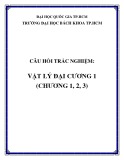
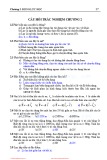
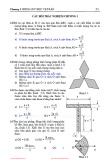

![Câu hỏi trắc nghiệm Cơ kỹ thuật [chuẩn nhất]](https://cdn.tailieu.vn/images/document/thumbnail/2014/20141226/gonvo_93/135x160/4731419585192.jpg)

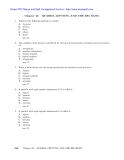
![Tuyển tập ngân hàng đề kiểm tra Vật lý (Physics Test Bank) chọn lọc [năm]](https://cdn.tailieu.vn/images/document/thumbnail/2012/20120227/kata_3/135x160/physics_test_bank_split_43_8303.jpg)
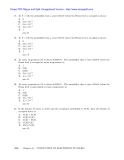








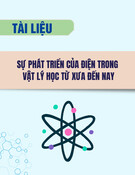
![Bộ câu hỏi lý thuyết Vật lý đại cương 2 [chuẩn nhất/mới nhất]](https://cdn.tailieu.vn/images/document/thumbnail/2025/20251003/kimphuong1001/135x160/74511759476041.jpg)
![Bài giảng Vật lý đại cương Chương 4 Học viện Kỹ thuật mật mã [Chuẩn SEO]](https://cdn.tailieu.vn/images/document/thumbnail/2025/20250925/kimphuong1001/135x160/46461758790667.jpg)




